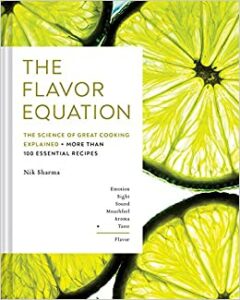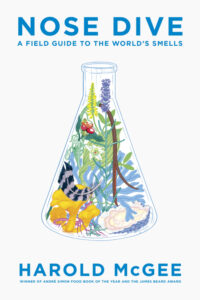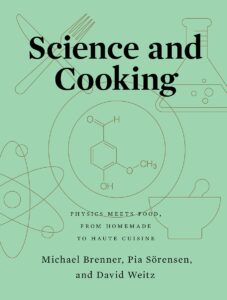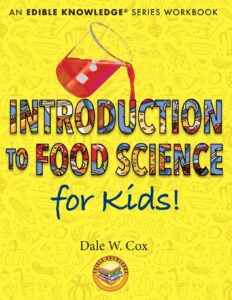
Due to my extended break from blogging it turns out I haven’t recommended books here at Khymos since 2013! As you know I do keep an eye open for books about food that have a certain scientific touch. Let me start off with some recommendations for books published in 2020:
 The Flavor Equation The Flavor Equation
by Nik Sharma
352 pages, 2020
The book has about 100 recipes and the great thing is that the science part is integrated into each recipe by providing small hints under the heading “The Flavor Approach”. Bonus for metric units! The remaining one third of the book deals with flavor from many perspectives. The science part is easily accessible. Highly recommended! |
 Nose Dive: A Field Guide to the World’s Smells Nose Dive: A Field Guide to the World’s Smells
by Harold McGee
688 pages, 2020
If you’ve shown any interested in food and cooking from a scientific perspective you will most certainly have come across McGee’s book that ignited my interest in the field, On Food and Cooking: The Science and Lore of the Kitchen. His latest book is entirely devoted to smells – not only that of foods, but really everywhere. Even though the volatile molecules discussed are named I would say the science bit should not frighten you off if you’re interested in the subject. I’m looking forward to dive properly into this one!(note that the book has different covers in UK and US) |
 Science and Cooking: Physics Meets Food, From Homemade to Haute Cuisine Science and Cooking: Physics Meets Food, From Homemade to Haute Cuisine
by Michael Brenner, Pia Sörensen, and David Weitz
320 pages, 2020
The three authors started teaching the Science and Cooking class at Harvard University 10 years ago. Many of the lectures are available on Youtube and over the years they have featured a great number of notable chefs, scientists and authors who share a common interest in the intersection of science and cooking. The authors’ scientific background range from applied maths to chemistry and physics, and they do a great job integrating this with the food topics being discussed. The science parts go hand in hand with recipes. Bonus for metric units! |
 The Art and Science of Foodpairing The Art and Science of Foodpairing
by Peter Coucquyt, Bernard Lahousse, and Johan Langenbick
388 pages, 2020
If you’ve followed Khymos for a while you may have read my interview with Bernard Lahousse and my reports from The Flemish Primitives conferences in Belgium. I find the topic of flavor pairing quite interesting, even though it’s been criticized and is seen as controversial by some. The company Foodpairing have taken the concept a long way, and results have now been compiled into this book. Where the science ends (or reaches an end) the art takes over, so inspiration in the kitchen is guaranteed anyhow. |

Masala lab
by Krish Ashok
280 pages, 2020
I’m so delighted to see regional cuisines being given a scientific treatment as well! The author is an electronic/software engineer and he brings his curiosity into the kitchen. Apparently the book is only available from Amazon in India, but I can’t wait to get my hands on a copy of this one! |
 150 Food Science Questions Answered: Cook Smarter, Cook Better 150 Food Science Questions Answered: Cook Smarter, Cook Better
by Bryan Le
198 pages, 2020
The book is structured on Q&As sorted into chapters covering cooking basics, flavor basics, and the main groups of ingredients. The last chapter is devoted to food safety and storage. I would recommend the book if you are new to bringing a scientific mindset into the kitchen. It’s the type of book you keep handy when you want to look something up, but if you browse through I’m confident you’ll find something that grabs your interest. |
 Introduction to Food Science for Kids!: A Kitchen-Based Workbook Introduction to Food Science for Kids!: A Kitchen-Based Workbook
by Dale W Cox
112 pages, 2020
I guess the title says it all! The kitchen is a perfect arena to introduce children to chemical and physical concepts. |
Below are some highlights from 2014-2019 (my favorites in bold):
- A Pinch of Culinary Science: Boiling an Egg Inside Out and Other Kitchen Tales by Erik Fooladi, Anu Hopia, 249 p, 2019
- Molecules, Microbes, and Meals: The Surprising Science of Food by Alan Kelly, 288 p, 2019
- Auditory Contributions to Food Perception and Consumer Behaviour by Charles Spence, 224 p, 2019
- Noma Guide to Fermentation by René Redzepi, David Zilber, 456 p, 2018
- The Flavor Matrix: The Art and Science of Pairing Common Ingredients to Create Extraordinary Dishes by James Briscione, Brooke Parkhurst, 320 p, 2018
- Science Of Spice by Stuart Farrimond, 224 p, 2018
- Principles of Food Chemistry by John M. deMan, John W. Finley, W. Jeffrey Hurst, Chang Yong Lee, 625 p, 2018
- Food Science: An Ecological Approach by Sari Edelstein, 678 p, 2018
- Modernist Bread by Nathan Myhrvold, Francisco Migoya, 2500 p, 2017
- Mouthfeel: How Texture Makes Taste by Ole G. Mouritsen and Klavs Styrbæk, 376 p, 2017
- The Science of Cooking: Every Question Answered to Perfect Your Cooking by Stuart Farrimond, 256 p, 2017
- Fennema’s Food Chemistry 5th Edition, edited by Srinivasan Damodaran and Kirk L. Parkin, 1123 p, 2017
- Salt, Fat, Acid, Heat: Mastering the Elements of Good Cooking by Samin Nosrat, Wendy MacNaughton, 480 p, 2017
- Gastrophysics: The New Science of Eating by Charles Spence, 336 p, 2017
- Chemistry in Your Kitchen by Matthew Hartings, 329 p, 2016
- The Science of Cooking: Understanding the Biology and Chemistry Behind Food and Cooking by Joseph J. Provost, Keri L. Colabroy, Brenda S. Kelly, Mark A. Wallert, 544 p, 2016
- Culinology: The Intersection of Culinary Art and Food Science by Research Chefs Association, 432 p, 2016
- Umami: Unlocking the Secrets of the Fifth Taste by Ole G. Mouritsen and Klavs Styrbæk, 280 p, 2015
- The Food Lab: Better Home Cooking Through Science by J. Kenji López-Alt, 958 p, 2015
- Molecular Gastronomy: Scientific Cuisine Demystified by Jose Sanchez, 320 p, 2014
- Note-by-Note Cooking: The Future of Food by Hervé This, 272 p, 2014
- The Perfect Meal: The Multisensory Science of Food and Dining by Charles Spence, 424 p, 2014


 The Flavor Equation
The Flavor Equation Nose Dive: A Field Guide to the World’s Smells
Nose Dive: A Field Guide to the World’s Smells Science and Cooking: Physics Meets Food, From Homemade to Haute Cuisine
Science and Cooking: Physics Meets Food, From Homemade to Haute Cuisine The Art and Science of Foodpairing
The Art and Science of Foodpairing
 150 Food Science Questions Answered: Cook Smarter, Cook Better
150 Food Science Questions Answered: Cook Smarter, Cook Better Introduction to Food Science for Kids!: A Kitchen-Based Workbook
Introduction to Food Science for Kids!: A Kitchen-Based Workbook